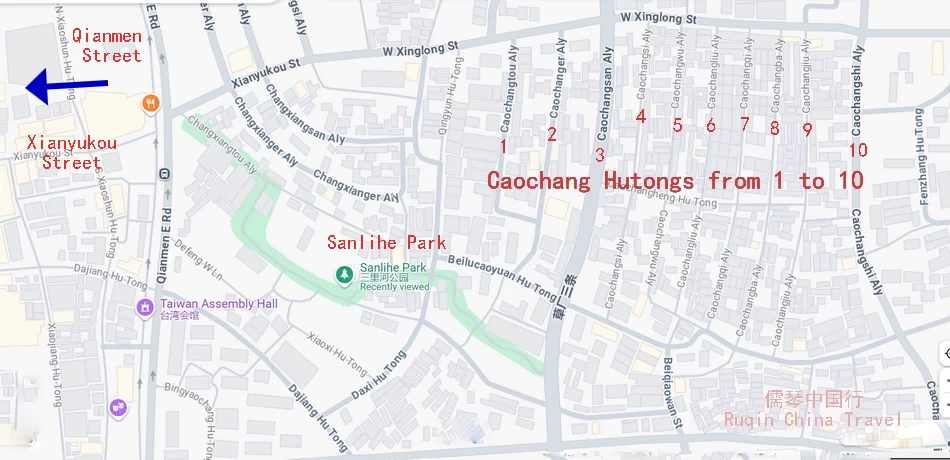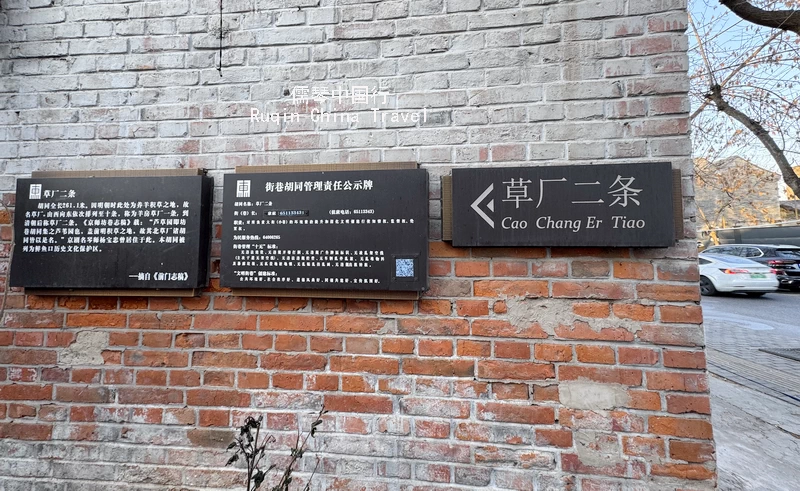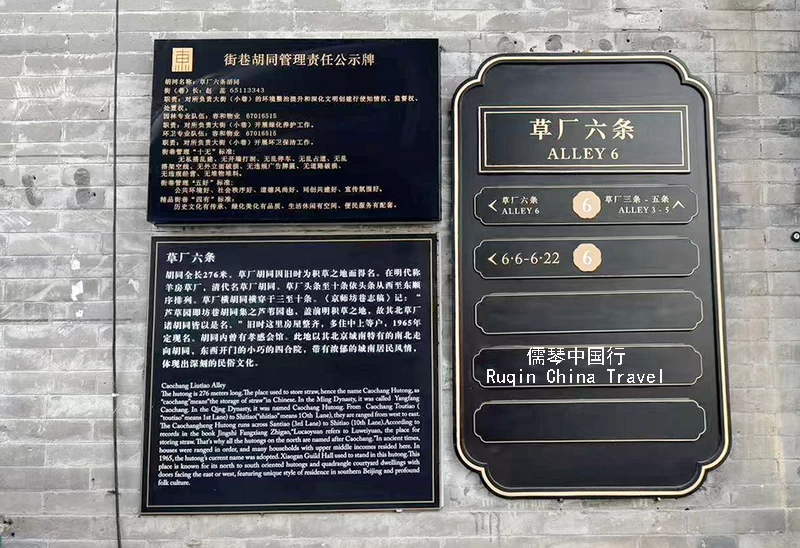Beijing, a city steeped in history and culture, offers travelers countless opportunities to explore its past through the traditional alleys known as hutongs. Among these, Caochang Hutongs (草厂) stand out as a hidden gem, offering a glimpse of authentic old Beijing life. These well-preserved alleys are located near Qianmen and remain largely untouched by commercialization, making them an ideal destination for those seeking to experience Beijing’s true charm. This guide will walk you through the Caochang Hutongs, covering everything you need to know for your visit, from historical background to the best things to see and do in the area.
Introduction to Caochang Hutongs
The Caochang Hutongs are located in the heart of Beijing, near the bustling Qianmen area. Unlike the more famous and heavily commercialized hutongs such as Nanluoguxiang, Caochang Hutongs provide a more serene and authentic experience. These alleys are not just remnants of old Beijing but are still lived-in, offering a true snapshot of local life. The hutongs are neatly arranged from west to east, with ten hutongs in total, and are the only north-south aligned hutongs in the city. The area is also one of the best-preserved historical hutong districts in Beijing, making it a perfect place to step back in time and see what life was like in ancient Beijing.

Walking through Caochang Hutongs, visitors can expect to see traditional courtyard homes, narrow winding lanes, and an old-world charm that’s hard to find in today’s fast-paced, modern Beijing. The simplicity of life in these alleys contrasts sharply with the busy streets and commercial centers surrounding them. Whether you’re an architecture lover, history enthusiast, or just someone looking for a peaceful escape, Caochang Hutongs will leave a lasting impression.
Caochang Hutongs Historical Background
Before the formation of these alleyways, the Caochang area served as an important site for the imperial court. The land was once used to store grass, which was critical for a variety of purposes. The grass was used for fuel, to feed livestock, and even to make materials like reed mats for protecting the city walls from rain. Over time, this area became a logistical hub, with the imperial court relying on it as a base for storing these essential resources. The name “Caochang,” meaning “grass fields,” originated from this very purpose.

Today, Caochang Hutongs remain a unique piece of Beijing’s history, with their charm and authenticity preserved in the very structure of the alleyways. The area has seen many changes over the centuries, but it has retained much of its old character. The Caochang Hutongs were recognized for their historical significance in 1999 when the Beijing Municipal Government listed them as one of the 25 historical and cultural preservation areas in the city.
What to See in Caochang Hutongs
Walking through the Caochang Alleys is like stepping into a time machine. The narrow streets are lined with traditional courtyard houses that still display many of the architectural features that defined old Beijing. From the intricate carvings on the eaves to the red wooden gates, the design of these buildings reflects the traditional aesthetic of old Beijing. Visitors can admire the vibrant green window frames and the decorative couplets on many of the doors, which often carry auspicious messages like “Loyalty and integrity pass down through generations” or “The fragrance of flowers fills the air.”

Unlike other popular hutong areas, the Caochang Alleys remain relatively quiet and less crowded, making it a peaceful spot for a stroll. The alleys are fairly narrow, with some being only two or three meters wide, just wide enough for a rickshaw. However, some of the hutongs, such as the Third and Tenth, are wider, accommodating cars and making them more accessible.
The area is home to 24 guild halls, which once served as social organizations for people from various regions. These guilds were funded by local communities and were central to the social fabric of old Beijing. The Caochang Alleys also feature the former residences of famous opera performers, offering insight into the artistic culture of the time.
Introduction to the Ten Caochang Alleys
The Caochang Hutongs consist of ten distinct alleys, each with its own unique character and history. These alleys, arranged from west to east, offer visitors a chance to step back in time and experience the authentic charm of old Beijing.
Each Caochang Hutong has a street sign on its northen end. Let’s take a closer look at each of the Caochang Alleys:

草厂头条 (Caochang Toutiao Alley)
Caochang Toutiao Alley (Caochang First Hutong) is 220.7 meters long and 4.8 meters wide. It starts at West Xinglong Street and curves to the east, connecting with Caochang Ertiao Alley.

During the Ming Dynasty, it was known as “Yangfang Caocang First Hutong” and later became Caochang Toutiao Alley in the Qing Dynasty. The Guangzhou Guild Hall once stood here, where the famous scholar Luo Yinggong lived.

Caochang First Hutong is recognised by Google Map as Caochangtou Alley.
草厂二条 (Caochang Ertiao Alley)
Caochang Ertiao Alley (Caochang Second Hutong) stretches for 246 meters and is 5.3 meters wide. This alley runs from West Xinglong Street to Beilucao Yuan Hutong.

It was officially named in 1965. In the past, it was home to several guilds including Shaozhou Guild, including those of Zeng Shaowu, Huanggang, and Yingcheng, showcasing the vibrant social life of old Beijing.

Caochang Second Hutong is recognised by Google Map as Caochanger Alley.
草厂三条 (Caochang Santiao Alley)
At 225 meters long and 4.8 meters wide, Caochang Santiao Alley (Caochang Third Hutong) starts at West Xinglong Street and ends at Beilucao Yuan Hutong.

Like other alleys, it was renamed in 1965. This alley was known for its guilds, including those of Nanling and Taiping, offering a glimpse into the region’s rich merchant culture.

Caochang Third Hutong is recognised by Google Map as Caochangsan Alley.
草厂四条 (Caochang Sitiao Alley)
Caochang Sitiao Alley (Caochang Fourth Hutong) is 304 meters long and 3.4 meters wide. It runs from West Xinglong Street to Beilucao Yuan Hutong.
Caochang Sitiao Alley is the best hutong of all the ten Caochang Hutontgs.

This alley retains much of its old-world charm with traditional courtyard houses. The absence of large crowds allows visitors to enjoy an authentic experience, with gates and stone decorations that reflect centuries of Beijing history. It is billed as the most beautiful alleys of all the ten.

Caochang Fourth Hutong is recognised by Google Map as Caochangsi Alley.
草厂五条 (Caochang Wutiao Alley)
Spanning 304 meters, Caochang Wutiao Alley ( Caochang Fifth Hutong) is 3.5 meters wide and slopes from north to south. It starts at West Xinglong Street and meets Caochang Liutiao Alley ( the sixth alley).

The alley once housed guilds such as Baoqing, Xianxi, and Huangmei, which played a significant role in supporting local communities and businesses in the area.

Caochang Fifth Hutong is recognised by Google Map as Caochangwu Alley.
草厂六条 (Caochang Liutiao Alley)
Caochang Liutiao Alley (Caochang Sixth Hutong) is 276 meters long and 3.6 meters wide. It runs from West Xinglong Street to Beilucao Yuan Hutong.

Known for its quiet charm, this alley was once home to the Xiaogan Guild Hall. Today, it still maintains a peaceful atmosphere, offering visitors a chance to experience the simplicity and beauty of traditional Beijing life.

Caochang Sixth Hutong is recognised by Google Map as Caochangliu Alley.
草厂七条 (Caochang Qitiao Alley)
Caochang Qitiao Alley ( Caochang Seventh Hutong) stretches for 315 meters and is 4.5 meters wide. This alley starts at West Xinglong Street and ends at Beilucao Yuan Hutong.

It was home to several guild halls, including Nan’an, Yuanzhou, and Huizhou. The blend of history and local culture makes it an intriguing spot to explore Beijing’s deep-rooted traditions.

Caochang Seventh Hutong is recognised by Google Map as Caochangqi Alley.
草厂八条 (Caochang Batiao Alley)
Caochang Batiao Alley (Caochang Eighth Hutong ) measures 326 meters in length and is 3.2 meters wide. It begins at West Xinglong Street and ends at Xuejiawan Hutong.

Once home to the Chen Yuan and Hanyang Guilds, this alley offers a glimpse into Beijing’s community life and the cultural exchanges that occurred here during the Qing Dynasty.

Caochang Eighth Hutong is recognised by Google Map as Caochangba Alley.
草厂九条 (Caochang Jiutiao Alley)
At 340 meters long and 4.3 meters wide, Caochang Jiutiao Alley (Caochang Ninth Hutong) starts at West Xinglong Street and ends at Xuejiawan Hutong.

This alley was once home to the Qizhou Guild, reflecting the region’s historic merchant ties and cultural networks. Today, it remains a charming and quiet place, with traditional courtyard homes lining both sides.

Caochang Ninth Hutong is recognised by Google Map as Caochangjiu Alley.
草厂十条 (Caochang Shitiao Alley)
The final alley, Caochang Shitiao Alley (Caochang Tenth Hutong), is 259 meters long and 4 meters wide. It starts at West Xinglong Street and ends at Xuejiawan Hutong.

Like other hutongs in the area, it was home to guilds such as those of Hunan, Changsha, and Changjun. This alley is a perfect spot to observe the well-preserved architecture and atmosphere of old Beijing.

Caochang Tenth Hutong is recognised by Google Map as Caochangshi Alley.
Cultural Atmosphere and Historical Figures at Caochang Hutongs
The Caochang Hutongs are a treasure trove of history, and they are an excellent place to learn about the cultural and artistic life of old Beijing. The area once served as a commercial hub, bustling with merchants and visitors from across China. The guild halls were a central part of this economy, serving as places where people could gather, socialize, and protect their mutual interests.

In addition to being the site of numerous guild halls, Caochang Hutongs is also home to several famous historical figures. The former residences of famous opera performers and scholars can still be seen in the area, offering a fascinating glimpse into the cultural life of Beijing during the Qing Dynasty.
The courtyards here are typically smaller than those in the northern parts of the city, but they are rich in character. Each home has a story to tell, and the overall atmosphere of the area reflects the strong sense of community and tradition that defined old Beijing.
Modernization of Hutong Life at Caochang Alleys
Despite their historical charm, the Caochang Hutongs have not been left behind in the modern world. In fact, they are at the forefront of modernization efforts. In 1999, Beijing designated the area as one of the city’s historical and cultural preservation zones, and since then, the district has undergone significant upgrades.

One of the most notable changes is the electric energy substitution program, which replaced gas-based heating and cooking systems with electric ones.
This modern development has not only made the area safer but has also improved the quality of life for the residents.
Similarly, public toilets in the area have been upgraded with modern amenities such as air conditioning, heating, and exhaust fans. These changes reflect the balance between preserving the area’s historic charm and introducing modern conveniences.
Transportation Guide for Caochang Hutongs
Getting to Caochang Hutongs is easy and convenient. The area is well-served by both public transportation and walking paths.
- Subway: You can take either Line 2 or Line 5 and exit at the B1 or B2 exit of Chongwenmen Station. From there, it’s a short walk to Caochang Hutongs.
- Bus: Several bus lines pass near Caochang Hutongs, including Routes 58, 101, 103, 109, 111, 128, Sightseeing Line 1, and Night Bus 13.
Once you’re in the area, take a stroll through the Caochang Alleys in this order: First Hutong, Second Hutong, Third Hutong, and so on,fianally reach Sanlihe Park.
Alternatively, take Line 8 to Qianmen Station (G Southeast Exit), and then it’s a 1.1 km walk to Sanlihe Park, then start to visit with Changxiang Hutong, further to Caochang First Hutong to Capchang Tenth Hutong.
Nearby Attractions and Food Recommendations
While visiting Caochang Hutongs, there are several nearby attractions and dining options to explore.
Attractions
- Sanlihe Park: A charming park with small bridges, flowing water, and scenic views, perfect for a relaxing afternoon.
- Qianmen Street: A lively street filled with shops and eateries, offering a more modern contrast to the historical Caochang Hutongs.
- Temple of Heaven: A short distance away, this UNESCO World Heritage Site is a must-visit for its architectural beauty and historical significance.
Food
- Douzhi (fermented mung bean drink), Jiaoquan (fried dough rings), and Xian Cai (pickled vegetables) can be found near the Temple of Heaven.
- Xianyukou Food Street and restaurants along Qianmen Street offer a wide variety of Beijing snacks and traditional dishes.
Conclusion
If you’re looking to experience the true essence of old Beijing, Caochang Hutongs is the place to be. These Caochang alleys offer a rare glimpse into the traditional lifestyle of the city’s residents, with their narrow lanes, traditional courtyard homes, and rich history. The blend of old-world charm and modern conveniences makes the area a must-visit for anyone looking to experience Beijing beyond the tourist hotspots. Whether you’re interested in history, architecture, or just a peaceful stroll through the heart of old Beijing, Caochang Hutongs Beijing will not disappoint.


